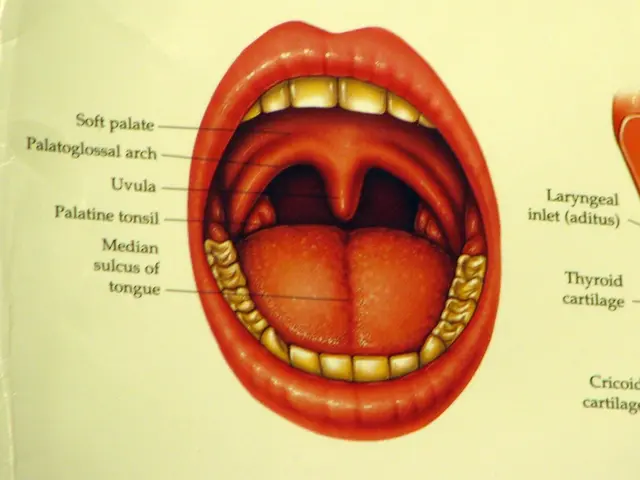Connection between Breast and Ovarian Cancer: Identified Links and Risk Factors
Rewritten Article:
Breast Cancer and Ovarian Cancer: A Genetic Connection
There's a solid link between breast cancer and ovarian cancer, primarily due to shared genetic factors, particularly for individuals harboring mutations in the BRCA1 and BRCA2 genes. Let's delve into this intricate relationship.
Both breast and ovarian cancers share common genetic risk factors. People with these risk factors may have an increased likelihood of developing both cancers.
The Connection Between Breast and Ovarian Cancer
According to research, individuals who have battled breast cancer might have an elevated risk of ovarian cancer. This risk is particularly high if the breast cancer is related to genetic mutations in BRCA1 or BRCA2. However, this increased risk traces back to the underlying genetic factors rather than the disease itself.
Data suggests that people with breast cancer are approximately twice as likely to develop subsequent ovarian cancer. On the other hand, those with ovarian cancer have a 1.6-fold increased risk of subsequent breast cancer, although the risk varies over time since the initial diagnosis.
In the same vein, ovarian cancer increases the risk for breast cancer, often due to genetic mutations.
Other Shared Risk Factors
Besides genetics, other factors that may influence the risk of both breast and ovarian cancer include:
- a family history of either cancer
- older age, with ovarian cancer typically occurring in individuals over 40 years, and breast cancer in those ages 55 years or older
- maintaining an unhealthy weight
- giving birth to one's first child after the age of 30
- never having children
- not breastfeeding
- hormone therapy after menopause
Reducing the Risk
While some risk factors, such as having had breast or ovarian cancer previously, are unalterable, managing these unchangeable risk factors can involve careful monitoring, lifestyle changes, and, in some cases, preventive medical procedures.
A history of breast cancer boosts the risk of ovarian cancer and vice versa, particularly if these cancers are associated with genetic mutations like BRCA1 or BRCA2. While this risk factor cannot be altered, it can be managed.
Healthcare professionals might recommend that people with a history of breast or ovarian cancer undergo more frequent and thorough screenings to catch any new cancers early. This might include:
- regular mammograms
- breast MRI scans
- pelvic exams
- transvaginal ultrasounds
- CA-125 blood tests
Genetic testing for BRCA1, BRCA2, and other relevant mutations is the best strategy for monitoring and prevention. For those carrying genetic mutations, doctors may consider additional options such as prophylactic surgeries.
Modifiable Risk Factors
Manageable risk factors include:
- Weight: Losing and maintaining a healthy weight can help reduce the risk of both breast and ovarian cancers.
- Regular Exercise: Regular physical activity has been linked to a lower breast cancer risk, and limited evidence supports a link with ovarian cancer. Exercise can help maintain a healthy weight and may also have direct anticancer effects.
- Alcohol: Consuming less alcohol may lower the risk of breast cancer. The risk escalates with the amount consumed, so healthcare professionals might advise limiting one's intake.
- Oral contraceptives: Oral contraceptives may lower the risk of ovarian cancer but may slightly increase the risk of breast cancer. People can discuss contraception options with a doctor to weigh the risks according to their circumstances.
Outlook
Recent research suggests that people diagnosed with both primary breast cancer and primary ovarian cancer have relatively optimistic outlooks, with 5- and 10-year overall survival rates pegged at around 90%. The prognosis tends to be more positive when the interval between the two diseases is longer. However, ovarian cancer following breast cancer often results in a later diagnosis stage, which can impact survival.
A person's age during their first cancer diagnosis and the time between the two cancers significantly influence the overall outlook. For more personalized information about one's prognosis, it's best to consult with a healthcare team.
When to Consult a Doctor
If you notice signs or symptoms of breast or ovarian cancer, particularly with a personal or family history of these diseases, it's essential to consult a doctor. Remaining vigilant for signs of recurrence or a second cancer after a previous diagnosis of breast or ovarian cancer is crucial for early detection and prompt treatment.
Enrichment Data:
Understanding these risk factors can help individuals take proactive steps to manage their risk and ensure early detection and treatment. Shared and modifiable risk factors for both breast and ovarian cancer include genetic mutations, lifestyle factors, and hormonal influences. BRCA1 and BRCA2 gene mutations are significant genetic risk factors that increase the risk of both cancers.
Other shared risk factors include:
- Genetic Mutations: Other genetic factors, in addition to BRCA1 and BRCA2, can contribute to the risk of both breast and ovarian cancer.
- Lifestyle Factors: Intake of alcohol, smoking, and a sedentary lifestyle can increase the risk of breast and ovarian cancer. Conversely, living a healthy lifestyle, such as maintaining a healthy weight through regular exercise and a balanced diet, may help lower the risk.
- Hormonal Factors: Hormone replacement therapy (HRT), reproductive factors like late full-term pregnancy or never having a full-term pregnancy, and excessive exposure to estrogen or progesterone can increase the risk of both breast and ovarian cancer. Oral contraceptives may lower the risk of ovarian cancer but may slightly increase the risk of breast cancer.
For those carrying genetic mutations, doctors may consider additional options such as prophylactic surgeries, which involve removing organs or tissues to prevent the occurrence or spread of cancer. Understanding these risk factors and one's personal risk can empower individuals to make informed decisions about prevention and early detection strategies.
- The connection between breast cancer and ovarian cancer is primarily due to shared genetic factors, specifically for individuals harboring mutations in the BRCA1 and BRCA2 genes.
- People who have battled breast cancer might have an increased risk of developing ovarian cancer, with the risk being particularly high if the breast cancer is related to genetic mutations in BRCA1 or BRCA2.
- In contrast, ovarian cancer increases the risk for breast cancer, often due to the presence of these same genetic mutations.
- Genetic testing for BRCA1, BRCA2, and other relevant mutations is the best strategy for monitoring and prevention in people with a history of breast or ovarian cancer.
- Managing unchangeable risk factors for both breast and ovarian cancers can involve careful monitoring, lifestyle changes, and, in some cases, preventive medical procedures.
- Maintaining a healthy weight through regular exercise and a balanced diet can help reduce the risk of both breast and ovarian cancers.
- For those carrying genetic mutations, doctors may consider additional options such as prophylactic surgeries to help prevent the occurrence or spread of cancer. These surgeries involve removing organs or tissues.








